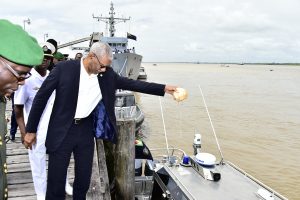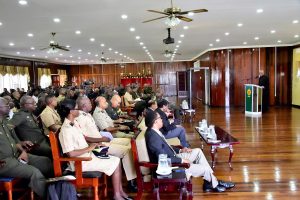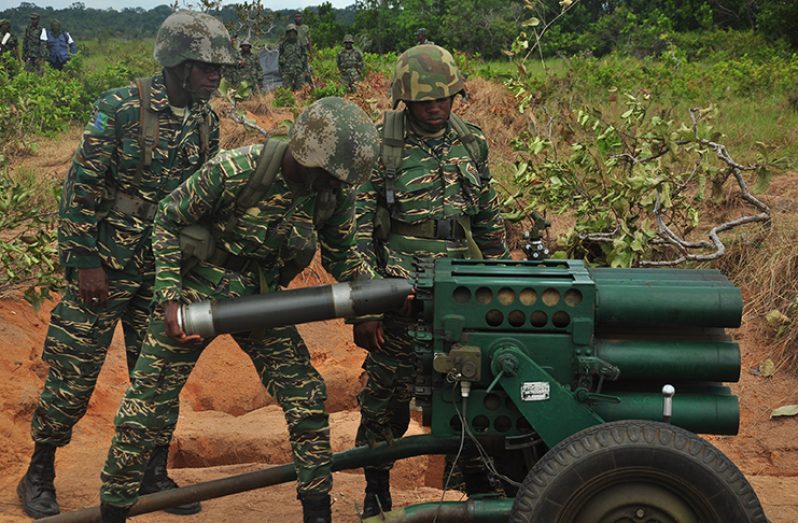
THE Government of Guyana has a constitutional mandate to defend national independence, preserve the country’s sovereignty and integrity and guarantee normal functioning of institutions and security of citizens against any armed aggression. The Guyana Defence Force (GDF)is similarly mandated by the Constitution to defend the territorial integrity of Guyana, contribute to the economic development of the country and to assist the civil powers in the maintenance of law and order.

The Constitution of the Cooperative Republic of Guyana, Article 197 A(1) stipulates “The State’s defence and security policy shall be to defend national independence, to preserve the country’s sovereignty and integrity, and to guarantee the normal functioning of institutions and the security of citizens against any armed aggression”.
It is in this regard that President David Granger and Commander-in-Chief of the Armed Forces has proposed a strategy for ‘Total National Defence’ by the GDF. According to the Head of State, Total National Defence implies that all of the elements; all of the instruments of national power, need to constantly be employed, in order to protect Guyana, particularly as the threats to its sovereignty continue.
In his address to Officers of the Force on October 15, 2015, President Granger said that “The principal purpose of the Guyana Defence Force is to provide the potential for the application of force to ensure the security of the nation, the freedom of its people and the promotion of the national interest. Defence policy must determine the structure and capabilities of the defence force and guide the contribution it makes to the country’s defence and security goals in accordance with foreign and economic policies.”
Total National Defence
Guyana needs a well-commanded, well-trained, well-equipped defence force with the core capabilities of keeping citizens safe and secure and the GDF, in an effort to fulfil its mission, must be multi-role, flexible and fully integrated with sufficient support weapons.
To ensure this, President Granger has noted that the Total National Defence must look at five main pillars, namely personnel, readiness, infrastructure, moral and equipment. With regard to personnel, the Commander-in-Chief has said that the Force must be brought up to the authorised strength to meet current and unforeseen challenges. The Force must also maintain its ‘esprit de corps’, he said, in order to enable troops to support its mission and to function as a unit in order to achieve its objective.
On January 25, 2018 at the opening of the GDF Annual Officers’ Conference, the Head of State announced that the reinforcement of the Force’s high command, which started with the restoration of the appointments of Adjutant General, Inspector General, Quartermaster General (QMG) and Commandant of the Guyana People’s Militia, under his stewardship, have allowed dedicated superior officers to pay undivided attention to personnel and soldiers’ morale, the improvement of soldiers’ living conditions, a high state of operational readiness and interoperability with fraternal Caribbean defence forces and the mobilisation and training of reserve personnel.
“The Force is being brought up to its authorised strength to allow it to be deployed to any part of the country, in any weather or terrain and at short notice. The ‘reserve force’ – the Guyana People’s Militia – is being re-built in every administrative region. The Militia is an essential arm of the Regional system. Each regional capital town will have its own unit, eventually, to enable to respond more promptly to render assistance to residents in the event of emergencies. The Force is the premier agency charged with responsibility to protect our homeland against the new security threats such as environmental degradation, flooding and drought. The Force is being readied to support the Government’s law-enforcement efforts to combat trafficking in illegal weapons and narcotics and transnational terrorism,’ he said.
Readiness

To be prepared and ready, he noted that the Force must be prepared to deploy to any part of Guyana, at short notice in response to direction by the Guyana Defence Board. Readiness refers also to the resources needed to conduct training and to prepare units for operations.
The President has also mandated regular military Exercises to ensure that the Force can fulfil its mission to protect Guyana’s territorial integrity and is in a state of preparedness for any security threat, which may arise. The Exercise is designed to assess the GDF troops in Close Country Warfare (CCW) and Open Country Warfare (OCW) simulations of battle. In this regard, this year’s ‘Exercise IRONWEED’ culminated on August 15, 2018, with the “Final Attack” in the savannahs of the Colonel John Clarke Military School at Tacama with the participation of over 1500 troops in the 10-day exercise.
Congratulating the troops following the conclusion of IRONWEED, Chief-of-Staff Brigadier Patrick West announced that the activity will be done on an annual basis. “In this Exercise, we have tested and assessed our coordination, synchronisation, and standardisation of (battle-ready) operational procedures. We have demonstrated our capacity for mobilisation, deployment, concentration of force, battle procedure, fire and assault support, among other things. I am proud to announce that this is the first time that we have had so many troops involved in this type of exercise. This was because of the embodiment of more than 200 reservists from the Guyana People’s Militia,” he said.
The Chief-of-Staff also noted that as the exercise continued each year, various adjustments to format and operational procedure would be initiated as necessary. This, he said, would be in keeping with the need to ensure sharper and more precise focus in battle-readiness and operational efficiency.
Infrastructure
As it relates to infrastructure, the Commander-in-Chief said that the condition of airstrips, the condition of barracks, the condition of hangers, wharves and other infrastructure, must be maintained in a serviceable condition in order to enable the force to conduct operations from them.

“The Engineer Corps will once again be built up to the level that it can assist the Ministry of Public Infrastructure to complete these roads and bridges in the hinterland because this is what the government feels should be necessary to develop this country,” he said.
Already, the Force has started to undergo a significant restructuring programme to allow for a greater level of efficiency in the execution of its mandate and to ensure maximum development within the Force. Changes are being made to the Engineering Corps, with greater emphasis being placed on public infrastructure, the Agriculture Corps, which will focus on food production for the Force and victims of natural disasters and the Signal Corps, which will be re-established as the main arm for the advancement of information and communications technologies and telecommunications within the Force.
“Several Corps of the Force are being re-formed and re-capitalised. The Agriculture Corps will embark on agro-processing in order to produce foods, which can be preserved and packaged as compact rations for soldiers on long-range patrols and field operations and as emergency supplies to citizens affected by natural disasters such as floods. The Air Corps and Coast Guard will be upgraded to allow for continuous surveillance over our airspace, maritime space and land-space and to support search-and-rescue services to persons in distress. The Engineer Corps will be restructured and re-equipped to enable it to re-engage in the development of public infrastructure and assist in disaster relief efforts in other countries affected by natural disasters. The Corps will expand the Force’s capability to generate electrical energy from renewable sources in all military bases and camps,” the Head of State has said.
Resources
In every job, equipment and resources are necessary to accomplish the task at hand. The Head of State recognises this and has noted that the Force must have the capability to maintain adequate, combat ready units with the correct mix of personnel and equipment.
“Aircraft, road vehicles, maritime vessels inevitably will be degraded over time but they must be repaired or replaced if efficiency is to be ensured. And sometimes, I fly in highlanders owned by private operators; which I used to fly in thirty years ago, owned by the defence force and I wonder why we couldn’t maintain them ourselves, why we couldn’t maintain our fleet. The Air Corps must be upgraded to provide continuous surveillance over Guyana’s air, territorial and maritime borders and approaches, and support search and rescue services to persons in distress. The Coast Guard unit must be upgraded to be permitted to provide continuous surveillance over Guyana’s sea space. It must be able also to provide search and rescue services to persons in distress. Maritime security is a serious matter,” the Head of State said during his address to Officers.

On March 30, 2017, the Commander-in-Chief in direct demonstration of the Government’s support to the recapitalisation of the Coast Guard and to ensure the protection of marine assets, the prevention of transnational crime and the promotion of international and coastal trade, commissioned two new vessels at the Coast Guard Ship Hinds (GCGSH) at Ruimveldt. The two boats are Metal Shark 38V Defiant Class vessels, which were purchased by the Government of Guyana at a cost of $140 million each and are outfitted with three 300 horsepower engines and measure 38 feet in length.
Further to this, Minister of State, Mr. Joseph Harmon, who also serves as the Secretary to the Defence Board, today, said that the Government of Guyana is committed to providing the necessary resources and equipment to the Guyana Defence Force (GDF) so that it can effectively fulfil its mandate as he commissioned two new Islander planes for the Force’s Air Corps on August 10, 2018.
Speaking at a simple ceremony held at Air Station London, Timehri, the Secretary of the Defence Board said that the acquisition of the planes is part of Government’s plans for the recapitalisation of the Force as outlined by President David Granger in the ‘Total National Defence Policy.’
“The Total National Defense Policy is designed to give our regular and reserve forces the resources they need to perform their mission. This policy is based on five pillars: personnel, readiness, infrastructure, morale and equipment. A policy is a course or principle action adopted or proposed by a government. A policy is followed by a plan and a plan has to be implemented. All of this has to be driven by interest and the will of the state for there to be concrete action and subsequent success. In consideration of what I have just stated, this ceremony is therefore strong evidence that the President of Guyana has outlined a policy, a plan is being pursued and is being implemented, part of which is the acquisition of these two aircraft. This ceremony speaks directly to the part of the “Total National Defence Policy’ that specifically addresses the issue of resources. The Guyana Defence force and the Air Corps must be properly equipped to carry out its mandate,” he said.
The Minister of State noted that the Government of Guyana will not hesitate to provide the support necessary to ensure that the servicemen and women are fully equipped to uphold the Constitution and protect Guyana. The aircraft, he said, represent an investment that demonstrates the Government’s commitment to ensuring that the GDF receives the necessary aviation support required to execute its mandate.
“These aircraft being received today will engage in activities that include ensuring the security and integrity of our borders, the security and integrity of our maritime space, especially with regard to the activities related to the production of oil and gas and anti-piracy efforts, provide support to the resuscitated Engineering Corps of the GDF in its activities with regard to the infrastructural development in the hinterland, promote the policy of equal development and the delivery of public services and bridging the gap between our coastland and hinterland communities and supporting the establishment of a ‘green economy’ and ‘green’ state by monitoring activities in our forest for the control and mitigation of carbon emissions that affect climate change,” he said.
Minister Harmon noted too that it would also assist in the maintenance of the integrity of the country’s protected areas, improve the security and protection of citizens in the hinterland especially indigenous communities, improve relations and the delivery of resources and infrastructure to hinterland communities and facilitate medical evacuations from hinterland communities.
“It will also ensure that our men and women in uniform have the necessary service support. I remember days when I was an Officer and we had to wait days for an aircraft for replenishments in remote areas. We are doing better now so all of our men and women must understand that what we are doing as Government is providing a reliable source of support for them. They must know that there is a chain behind them that is strong and that will provide support. I have been assured that the aircraft are the best suited to our conditions and the objectives to be achieved by the Air Corps in the execution of its functions. I have also been advised that they are the most economical option available to the GDF for the expansion of its Air Corps. I must, however, urge you, beseech you to take good care of this investment; to care these aircraft; to ensure their proper maintenance and use so that the GDF and the people of Guyana can have the maximum benefit of their investment,” Minister Harmon urged.
Chief of Staff of the Force, Brigadier Patrick West has said that in addition to the Islanders, the Force expects to acquire two more Skyvans in the coming months to add to its fleet.
“Words cannot express our profound gratitude over the continued support that produce results such as these. These aircraft, as you were told, will enhance our surveillance capabilities and provide increased support for our forward locations. It is also envisaged that they will provide much-needed assistance in administrative and other duties and contribute to the continued support for our civil defence operations,” he said.
Commanding Officer of Air Corps, Commander Courtney Burns said that the Corps plays an integral role in the Force’s functions and is therefore inspired that Government has seen it fit to add to its resources.
“The Air Corps is indeed inspired by this acquisition and we know this is only the beginning but we are inspired. We are re-energised as we continue to be driven by our motto of ‘Service’. No military can be effective without an effective Air Force. Our mission is to provide aviation support to the Guyana Defence Force. This support comes in the form of 16 tasks, namely search and rescue as required, airborne and airmobile operations,, casualty evacuations, day and night medical evacuation, air transport for troops, platform for tactical operation, surveillance through the country including the Exclusive Economic Zone, disaster relief operations, replenishment plans for those deployed, provide support for government programmes, conduct trainings, conduct anti-piracy, anti-illegal mining, logging and fishing activities, support civil powers and the police, provide internal support operations, conduct counternarcotic operations and cross-border operations. These islanders will be directly employed in the conduct of those operations with the exception of one or two,” he said.
Defence cooperation
Over the years, Guyana has received tangible support from its bilateral partners. This year, Guyana and Brazil are celebrating 50 years of friendly diplomatic relations and the two States have recommitted to strengthening ties and pursuing cooperation programmes particularly in the area of defence.
The two nations on February 10, 2018, during a State visit by Brazil’s Minister of Defence, Mr Raul Jungmann Pinto, along with a high-level delegation, which included Brazil’s Minister of Justice, Mr Torquato Lorena Jardim, held high-level talks to bolster defence cooperation.
The bilateral engagement, which was hosted at State House, saw a commitment by both countries to review the September 2012 Joint Communiqué, which followed the official visit to Guyana by Ambassador Celso Amorim, then Minister of Defence of Brazil. The review is intended to update the agreements in that document and bring them in line with present-day realities, as well as, to deepen defence cooperation.



.jpg)








